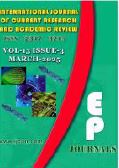Abstract Volume:13 Issue-3 Year-2025 Original Research Articles
 |
Online ISSN : 2347 - 3215 Issues : 12 per year Publisher : Excellent Publishers Email : editorijcret@gmail.com |
Garlic is one of the most vital plant in the world, coming in second after onions in terms of significance and production. However, due to inadequate agronomic methods, a lack of enhanced varieties, diseases, and insect pests, productivity per hectare is low. Hence, an on-farm experiment was carried out to assess the impact of various NPS fertilizer and farm yard manure rates on the growth and yield of garlic, as well as to determine the most cost-effective amounts of farm yard manure and NPS fertilizer for garlic cultivation. The treatments comprised factorial combinations of four levels of farmyard manure (0, 0.5, 1, and 1.5 tons ha-1) and five rates of NPS (0, 50, 100, 150, and 200 kg ha-1), and were arranged in a randomized complete block design (RCBD) with three replications. The analysis of variance revealed that NPS fertilizer had a significant impact on plant height, whereas farm yard manure had a significant impact on clove length. Conversely, both FYM and NPS fertilizers had a significant impact on the number of days needed to attain 90% physiological maturity, the number of leaves per plant, leaf length, and the number of cloves per bulb. The shortest days to reach 90% maturity were observed without the use of fertilizers, at 130.8 days and 131.2 days. The greatest plant height (70.50 cm) was recorded at 150 kg NPS ha-1, which was statistically similar to 200 and 100 kg NPS ha-1. The highest number of leaves per plant (9.23) and (9.65) were obtained from 150 kg NPS ha-1 fertilizer and 0.5 tone FYM ha-1, respectively, whereas the longest leaf lengths (48.91) and (48.75) were recorded from 150 kg NPS ha-1and 1.5 tones FYM ha-1, respectively. The greatest number of cloves per bulb (18.21) and (18.23) were recorded from 1 tone FYM ha-1 and 100 kg NPS ha-1, respectively, while the maximum clove length (2.49) was recorded from 0.5 tone FYM ha-1. The interaction effects of FYM and NPS fertilizer had a significant impact on total bulb yield, clove weight, and bulb weight. The highest bulb weight (30.77 g) was obtained from 0.5 tone FYM ha-1 and 150 kg NPS ha-1, while the highest clove weight (2.83 g) was obtained from 0.5 tone FYM ha-1 and 100 kg NPS ha-1. The highest yield (12.91 tone ha-1) was obtained from 0.5 tone FYM ha-1 and 150 kg NPS ha-1, while the lowest yield (9.76 tone ha-1) was obtained from garlic that did not receive any FYM or NPS. The economic analysis further showed that the greatest net return of 2,316,300 ETB ha-1, with a marginal rate of return of 308.84%, was achieved with the application of 0.5 ton FYM ha-1 and 150 kg NPS ha-1. Consequently, depending on the findings of the yield, growth, yield parameters, and economic analysis, the use of 0.5 ton FYM ha-1 and 150 kg NPS ha-1 can be provisionally suggested to farmers for garlic production in the research region.
How to cite this article:
Chala Gutema and Gemechu Ijigu. 2025. Effects of Farm Yard Manure and NPS Fertilizer Rates on Growth and yield of Garlic (Allium sativum L.) at Bale Highlands and Mid-altitude.Int.J.Curr.Res.Aca.Rev. 13(3): 35-44doi: https://doi.org/10.20546/ijcrar.2025.1303.005



Quick Navigation
- Print Article
- Full Text PDF
- How to Cite this Article
- on Google
- on Google Scholor
- Citation Alert By Google Scholar
